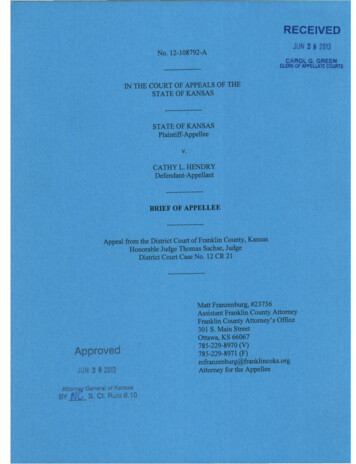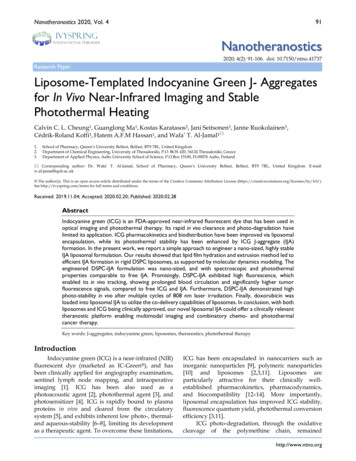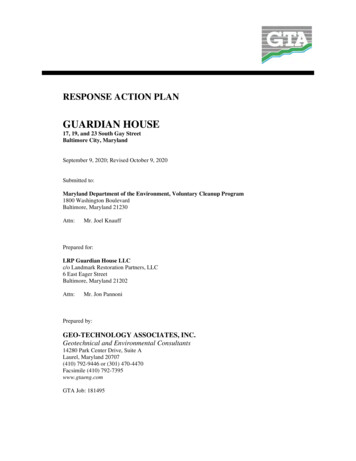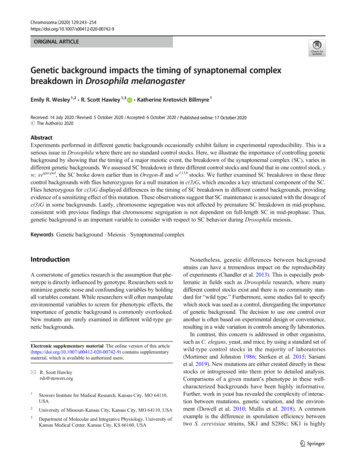
Transcription
RECEIVEDNo. 12-108792-AJUN 2 8 2013CAROL G. GREENCLERK OF APPELLATE COURTSIN THE COURT OF APPEALS OF THESTATE OF KANSASSTATE OF KANSASPlaintiff-Appelleev.CATHY L. HENDRYDefendant-AppellantBRIEF OF APPELLEEAppeal from the District Court of Franklin County, KansasHonorable Judge Thomas Sachse, JudgeDistrict Court Case No. 12 CR 21ApprovedJUN 2 8 2013 .AttBY9 Generlill of KansasNt,;. S. Ct. Rule 6.10Matt Franzenburg, #23736Assistant Franklin County AttorneyFranklin County Attorney's Office301 S. Main StreetOttawa, KS 66067785-229-8970 (V)785-229-8971 (F)mfranzenburg@franklincoks.orgAttorney for the Appellee
No. 12-108792-AIN THE COURT OF APPEALS OF THESTATE OF KANSASSTATE OF KANSASPlaintiff-Appelleev.CATHY L. HENDRYDefendant-AppellantBRIEF OF APPELLEEAppeal from the District Court of Franklin County, KansasHonorable Judge Thomas Sachse, JudgeDistrict Court Case No. 12 CR 21Matt Franzenburg, #23736Assistant Franklin County AttorneyFranklin County Attorney's Office301 S. Main StreetOttawa, KS 66067785-229-8970 (V)785-229-8971 (F)mfranzenburg@franklincoks.orgAttorney for the Appellee
Table of ContentsNature of the Case . 1Statement of Issues . 1Statement of Facts . . 1Argument and Authorities . 9Issue I:There was ample evidence to support a jury verdict of guilty.State v. McCaslin, 291 Kan. 697,245 PJd 1030 (2011) . 9K.S.A. 21-5301 . ·· . ··· . 14State v. Peterman, 280 Kan. 56, 118 P .3d 1267 (2005) . 14Issue II:The district court did not abuse its discretion in denying thedefendant's motion for a mistrial during voir dire.State v. Race, 293 Kan. 69,259 P.3d 707 (2011) . 16State v. Dixon, 289 Kan. 46, 209 P .3d 675 (2009) . 16State v. McClanahan, 259 Kan. 86, 910 P.2d 193 (1996) . 16State v. Ward, 292 Kan. 541,256 P.3d 801 (2011) . 17K.S.A. 22-3423 . 17State v. Mayberry, 248 Kan. 369, 807 P.2d 86 (1991) . 18State v. Gunby, 282 Kan. 39,144 P.3d 647 (2006) . 18State v. Baker, 227 Kan. 377, 607 P.2d 61 (1980) . 18State v. McCorgary, 224 Kan. 677,585 P. 2d 1024 (1978) . 18State v. Rhodes, 219 Kan. 281, 546 P.2d 1396 (1976) . 18State v. Kleypas, 272 Kan. 894,40 P.3d 139 (2001) . 20State v. Alexander, 240 Kan. 273, 729 P.2d 1126 (1986) . 20State v. Davidson, 264 Kan. 44, 954 P .2d 702 (1998) . 22Issue III:The district court did not violate the defendant's rights underApprendi v. New Jersey, 530 U.S. 466, 120 S.Ct. 2348, 147 L.Ed.2d 435(2000), by requiring her to register as an offender.Apprendi v. New Jersey, 530 U.S. 466, 146 L.Ed.2d 435, 120 S.Ct.2348 (2000) . 23State v. Allen, 283 Kan. 372, 153 P.3d 488 (2007) . 23State v. Chambers, 36 Kan. App. 2d 228, 138 P.3d 405 (2006), rev.denied 282 Kan. 792 (2006) . 23K.S.A. 22-4901 et seq . . 24State v. Unrein, 47 Kan. App. 2d 366, 274 P.3d 691 (2012) . 24K.S.A. 21-6601 . 24K.S.A. 21-6801 . 24Conclusion . 24
Nature of the CaseThe defendant, Cathy Hendry, was convicted of one count of attempted firstdegree murder and required to register as an offender pursuant to the Kansas OffenderRegistration Act. She appeals from her conviction and the court's order requiringregistration.Statement of the IssuesIssue I:There was ample evidence to support a jury verdict of guilty.Issue II:The district court did not abuse its discretion in denying thedefendant's motion for a mistrial during voir dire.Issue III:The district court did not violate the defendant's rights underApprendi v. New Jersey, 530 U.S. 466, 120 S.Ct. 2348, 147 L.Ed.2d435 (2000), by requiring her to register as an offender.Statement of the FactsThe defendant and the victim in this case, Joseph Soppe, began a romanticrelationship in September of 20 11. (R. Vol. IX, p. 193). Soppe stayed at thedefendant's home on numerous occasions between October, 2011 and January, 2012.CR. Vol. IX, pp. 193-94). During that time frame, Soppe moved some of his propertyinto the defendant's home, but he maintained his separate residence. (R. Vol. IX, pp.193-95, 199; R. Vol. X, pp. 427-28).In mid January, 2012, Soppe had a change of heart about the relationship anddecided to move most of his belongings out of the defendant's residence on January15th while she was at church. (R. Vol. IX, pp. 194-95). Soppe testified that the onlyitem of his that remained at the defendant's residence was his daughter's inflatablebounce house and blower.CR. Vol. IX, p.1?5, 200). He further testified that after hemoved his belongings out, the defendant "just showed up" at his house in
Vol. X, p. 433). Soppe and the defendant continued to call and text each other andsaw each other in person on a few occasions between January 15 and January 25,2012.CR. Vol. IX, pp. 195-96; R. Vol. X, pp. 435-42).On the evening of January 25,2012, Soppe decided to end the relationshipwith the defendant.CR. Vol. IX, pp. 196). Soppe was at work in Topeka andresponded to texts from the defendant asking him what he wanted out of therelationship.CR. Vol. IX, pp. 196-97). Soppe chose to break up with the defendantvia text because he was at work and unable to talk on the phone, and also because hewas uncomfortable with the defendant's previous decision to show up unannouncedat his home in Burlingame approximately 10 days earlier.CR. Vol. IX, pp. 197-98).The defendant was upset by Soppe's decision to break up with her; it was "painful"and "hurtful" and she "felt rejected[ .]" (R. Vol. X, p. 446). She also felt like her"heart had been ripped out of [her] chest" and that it was "very cruel" that Soppeinformed her of the breakup via text. (R. Vol. X, p. 447). However, she claimed shewas never angry with Soppe, despite not wanting the relationship to end and the factthat she felt betrayed.CR. Vol. X, pp. 470-71). Soppe testified that the defendant senta long text "chewing [Soppe] out" and calling him selfish. (R. Vol. IX, p. 198).The next morning, January 26th, Soppe got off work at 7 a.m. and texted thedefendant to ask if Soppe could come get his daughter's bounce house and blower.CR. Vol. IX, pp. 198-200). Soppe notified the defendant that he was on his way fromTopeka to retrieve his remaining property, and she responded that she was not readyfor him to come over.CR. Vol. IX, p. 201). According to Soppe's testimony, the2
defendant's reason for not being-ready wastIiarfi.er-kias (fia.-n6ry-e1-k.ilow-lliiirtlie-- - couple was breaking up, and the defendant did not want the kids to be at the housewhen Soppe arrived.CR. Vol. IX, pp. 201-02).The defendant also stated that shedidn't want Soppe to come over that morning because she had ajob class to go to at 9a.m. (R. Vol. X, pp. 472-73). Soppe agreed to wait until the kids had left for the dayand asked the defendant to place his daughter's bounce house on the driveway outsideso that he could just pick it up and leave. CR. Vol. IX, p. 202; R. Vol. X, p. 453).After learning that Soppe would be coming over, the defendant instructed herson, Joseph Hendry, to go upstairs with her to his bedroom. There, the defendant toldthe younger Hendry that she and Soppe were breaking up and that she wanted one ofher son's guns; she also told her son that she loved him.CR. Vol. IX, pp.165-67).Although the defendant saw that Joseph Hendry had his .22 rifle lying on hisbedroom floor, along with boxes of ammunition for it, she asked him to give her the20 gauge shotgun that was located on his gun rack on the wall. CR. Vol. IX, pp. 167,171; R. Vol. X, pp. 476-77). Joseph testified that his mother was familiar with the .22rifle and that she had shot it before; he also noted that the rifle was operable at thetime of this incident.CR. Vol. IX, pp. 164, 183-84).At the defendant's request, Joseph showed his mother how the shotgunworked, including how to load and unload the weapon and the need to pull thehammer back for the gun to be ready to fire.CR. Vol. IX, pp.175-77). Josephtestified that his mother asked for two shells for the single barrel shotgun, and he gaveher two turkey loads. CR. Vol. IX, p. 169). He also testified that the shotgun wasunloaded when he gave it to the defendant.3CR. Vol. IX, pp. 162, 177).The
for a second one. She also claimed that, despite the fact that her son always kept hisguns unloaded, he handed her the shotgun with a shell in the barrel. (R. Vol. X, pp.478-79). In any event, the defendant admitted that she asked for a second shellbecause she wanted one for insurance. (R. Vol. X, p. 479). After he had given thedefendant the shotgun and the two shells, Joseph Soppe saw the defendant take all ofthose items downstairs into her bedroom. (R. Vol. IX, p. 177). The defendantadmitted that she took the shotgun to her bedroom and that she placed the secondshell on the dresser behind the TV. (R. Vol. X, p. 480).Soppe arrived at the defendant's house around 8:15 a.m. expecting to see thebounce house in the driveway, but the bounce house was not there. (R. Vol. IX, p.205). Soppe texted the defendant from his car and she opened the overhead garagedoor and walked out to meet him. (R. Vol. IX, p. 206). The two had a five to tenminute conversation just inside the opened garage door about why the relationshipwas ending. (R. Vol. IX, pp. 207-08). During the conversation, Soppe noticed thatthe bounce house was not on top of the dryer in the garage, which is where it hadalways been stored. (R. Vol. pp. 200,207-08). Joseph Hendry also testified that hehad never seen the bounce house located anywhere in the house other than in thegarage, on what he believed to be an old washing machine. CR. Vol. IX, pp. 158-59).Joseph Hendry further testified that the bounce house was difficult to move aroundbecause it was heavy. (R. Vol. IX, pp. 159-60).During the course of their conversation, Soppe asked the defendant where thebounce house was; she told him that she moved it to the back room of the house, a4
distance that Soppe estimated-f6-0e70to-/-5Teeraw-ay--rromtIiegarage. -:1X;pp.208-10). The defendant's stated reason for moving the bounce house, instead ofplacing it in the driveway as Soppe had requested, was so she could put it in her car totake to Soppe's house.CR. Vol. IX, p. 208).This was despite the fact that thedefendant's car was located in the garage, very near to where the bounce house hadbeen stored.CR. Vol. IX, pp. 208-09).The defendant admitted that though thebounce house was "heavy" and "awkward," she was able to move it the length of thehouse because she had an "adrenaline rush" that morning, but she denied ever beingangry with Soppe.CR. Vol. X, p. 475).She stated that she put the bounce house inthe back bedroom with a plastic sack containing Soppe' s other belongings.CR. Vol.pp.475-76). Soppe testified that to his knowledge he had left no property at thedefendant's house except for the bounce house and the blower.CR. Vol. IX, pp. 208-09).Soppe followed the defendant from the garage and through the house andentered the back bedroom after the efendant indicated to him that she had placed thebounce house there.CR. Vol. IX, p. 211).This spare bedroom is directly across ahallway from the defendant's bedroom; there are no doors leading outside from theback bedroom.CR. Vol. IX, p. 210).As Soppe went into the spare bedroom, thedefendant turned into her bedroom across the hall.CR. Vol. IX, pp. 212-13).Soppeneeded to walk almost all the way into the bedroom, with his back to the doorway, inorder to reach the bounce house.CR. Vol. IX, p. 213).Sitting next to the bouncehouse Soppe found a plastic sack containing items that he did not recognize; hepicked up the sack to ask the defendant what was in it.5CR. Vol. IX, pp. 214-17).As
1 1 - - - - - - - - - - - - - - - - - - - - - - - - - - - - - ----- -he exited the spare bedroom, Soppe saw the defendant coming around heroedroomdoor holding a shotgun, walking toward Soppe.CR. Vol. IX, pp. 217-18).Thedefendant was holding the gun in both hands, one on the guard and one near thetrigger; Soppe saw the defendant's finger was actually on the trigger.CR. Vol. IX, pp.219-20). The defendant also admitted that she put her finger on the trigger.x, p. 488).CR. Vol.As the defendant walked toward Soppe, she held the shotgun at waistlevel. The gun was pointed at an angle across Soppe's body; first, it was pointedtoward his head but as he got closer, the defendant moved the gun toward Soppe' sabdomen.CR. Vol. IX, pp. 223-24).Soppe believed at this point he wasapproximately one foot away from the gun and that if it had gone off, he would haveCR. Vol. IX, p. 224).been shot in the abdomen.Soppe testified that the defendanthad a "pretty serious" look on her face and that she appeared "determined to dowhatever she was going to do;" Soppe believed that the defendant was going to shoothim.CR. Vol. IX, pp. 224-25).CR. Vol. X, p. 491,494).At no point did the defendant point the gun at herself.In fact, despite the elaborate planning the defendant hadengaged in prior to Soppe's arrival, she testified that she had never even consideredhow she was going to use the shotgun to kill herself.CR. Vol. X, p. 455,482).Thedefendant testified that her intention was to kill herself in front of Soppe so that hefelt "the hurt that [she] had and the pain;" however, she still denied being angry orwanting to punish Soppe.CR. Vol. X, pp. 460, 471).Soppe reacted quickly upon seeing the shotgun and pinned the defendant backagainst her bedroom wall, with the gun across her chest. CR. Vol. IX, p. 225; R. Vol.X, p. 457-58). As Soppe grabbed the barrel of the shotgun, the defendant started to6
pull the trigger, rri-a-ybe four or five times. (R. Vol. IX, pp. 226-27). The defendantthen tried to pull the hammer back on the weapon during the struggle, but Soppestopped her from doing so. (R. Vol. IX, pp. 225, 228). After several minutes ofstruggling, Soppe was able to operate the release mechanism, causing a shell to beejected from the shotgun; the shell ended up behind the dresser in the defendant'sbedroom. (R. Vol. IX, pp. 230-31). That shell, and the shell that the defendant hadplaced on her bedroom dresser, were both eventually located and seized by lawenforcement. (R. Vol. X, pp. 340-46). Again, at no point during this struggle did thedefendant point or attempt to point the shotgun at herself. (R. Vol. IX, p. 230).Soppe eventually obtained control over the shotgun and walked out of thehouse, leaving through the door to the garage. Soppe walked to his car and locked thegun in the vehicle. (R. Vol. IX, pp. 233-34). The defendant followed him from herbedroom out to the car and tried to get the shotgun from Soppe.CR. Vol. IX, p. 234).Soppe tried to use his phone to call the defendant's grandmother, but the defendanttried to stop him and told him she did not want her grandmother called.CR. Vol. IX,p.235). When Soppe told the defendant he was calling the police, she stated that shedidn't want to go to jail.CR. Vol. IX, p. 236).After Soppe called the police, thedefendant continued to fight to try to get to the shotgun and to try to prevent Soppefrom leaving.CR. Vol. IX, p. 241).Soppe had to push the defendant down onto theground in an attempt to get into his vehicle to drive away, but the defendant got upand grabbed the driver's side door as Soppe tried to close it. The defendant pulled sohard on the door that the door panel separated.7CR. Vol. IX, pp. 241-42).
After Soppe dro-ve away, the aefendant's claimedsuicidalcrisis·"passed-."· CR.Vol. X, pp. 460-61). Though she was aware that there was another gun in her son'sbedroom, the defendant did not attempt to retrieve it to cause herself harm.CR. Vol.X, pp. 497-98). In fact, almost immediately after Soppe left her home, the defendantdrove herself to a job skills class in Ottawa, approximately 15-20 miles away fromher home.CR. Vol. X, pp. 498-99).The defendant admitted the class was designed tohelp her gain employment and better her life.CR. Vol. X, p. 499).At no point did thedefendant reach out to her grandmother, other family, friends, or her job skills classteacher, despite the events that had taken place less than an hour before at her house.CR. Vol. X, pp. 499-500).The defendant was again suicidal when she was confrontedin her classroom by law enforcement, when she appeared "nervous" and told deputiesthat she "want[ed] to die."CR. Vol. X, pp. 329-34, 500-01).placed under arrest at this point.The defendant wasCR. Vol. X, p. 333).During voir dire at the trial, counsel for the State asked panel members if anyof them knew any of the attorneys on the case. Juror John Niccum responded that heworks for the Franklin County Sheriffs Department.CR. Vol. IX, p. 29).Niccumstated that he recognized State's counsel, but that he would be able to be fair andimpartial if he were selected as a juror. (R. Vol. IX, pp. 29-30). The district judgethen asked Niccum if he had any knowledge of the allegations in the case; Niccumstated that he only knew what the charges were on the arrest report. "(R. Vol. IX, p.30). The court then asked if Niccum had had any interaction with the defendant as aresult of the charges; Niccum replied, "Just interaction as far as providing for herdaily needs."CR. Vol. IX, p. 30).The remaining panel members were not informed8
---mIther about any otNiccum's duties, nor was tliere any discussion aboutthe custodystatus of the defendant at the time of trial.Additional facts will be discussed in the analysis section as necessary.Argument and AuthoritiesIssue I:There was ample evidence to support a jury verdict of gUilty.A. Standard of ReviewWhen sufficiency of the evidence is challenged in a criminal case, thestandard of review is whether, after reviewing all the evidence in a light mostfavorable to the prosecution, the appellate court is convinced a rational factfindercould have found the defendant guilty beyond a reasonable doubt. Appellate courtsdo not reweigh evidence, resolve evidentiary conflicts, or make witness credibilitydeterminations. State v. McCaslin, 291 Kan. 697,710,245 P.3d 1030 (2011).B. Analysisi.Premeditation and intent.Per jury instructions in the present case, in order to prove the defendant guiltyof attempted first degree murder, the State was required to provide proof beyond areasonable doubt that the defendant: 1) performed an overt act toward the commissionof the crime of murder in the first degree; 2) that she did so with premeditation andwith the intent to commit the crime of murder in the first degree; and 3) that shefailed to complete commission of the crime of murder in the first degree. The jurywas also instructed on the elements of the completed crime of first degree murder.eR. Vol. I, p. 60).The instructions defined "premeditation" for the jury as havingthought the matter over beforehand or to form the design or intent to kill before the9
act. -(4).The aefendantdoes-not-clialleng-e-the propriety of theseinstructions.The evidence of the defendant's premeditation was overwhelming in this case.Mr. Soppe had broken off a relationship with the defendant via text message the nightbefore the incident. The defendant felt that that was "very cruel," "painful," and"hurtful" and that she felt "very rejected". (R. Vol. X, pp. 446-47). The defendantpurportedly felt betrayed to the point that she planned to kill herself in front of Soppeto make him feel "hurt" and "pain," yet she claimed she was never angry with himabout the break up. (R. Vol. X, pp. 460, 470-71).As previously stated on pages three and four of the facts section, once thedefendant learned that Soppe wanted to retrieve his bounce house and blower the dayafter the break up, she devised a plan to lure him into her house to shoot him. Thedefendant told Soppe that he should not come over until after her kids had left forschool. She then ordered her son to go to his room with her and she asked him toshow her how his shotgun worked. The defendant also requested two shells for thesingle barrel shotgun, meaning that in order to fire both shells, she would be requiredto unload the spent casing and place the second shell into the weapon. After learninghow to operate the shotgun, the defendant took the weapon downstairs and placed itbehind her bedroom door. One shell was loaded in the gun, and the defendant placedthe second shell on a dresser right next to the bedroom door. (R. Vol. IX, pp. 162-69,175-77,201-02; R. Vol. X, pp. 479-80).Despite Soppe's request for the defendant to place the bounce house outsideon the driveway, the defendant carried the "heavy" and "awkward" bounce house10
from its usual storage place in the garage all the way to the back spare bedroom of thehouse due to an alleged "adrenaline rush."CR. Vol. X, p. 475).This was a sparebedroom with no exit, other than walking back down the length of the entire house.CR. Vol. IX, p. 210).The defendant told Soppe she did this so that she could load allof his property into her car to take it to him despite the fact that the bounce house wasnormally kept in the garage mere feet away from the defendant's car; by carrying thebounce house to the opposite end of the house, the defendant carried it as far awayfrom the car as she could.CR. Vol. IX, pp. 208-10).By luring Soppe to this back room, the defendant ensured that he had noescape route. Soppe also testified that the bounce house was not near the doorway ofthe spare bedroom; he needed to walk all the way into the room to reach it, and as hedid that, his back was inevitably to the only door leaving the room.CR. Vol. IX, pp.212-13). The defendant went with Soppe down the hallway and entered her bedroom,the same bedroom where she had hidden the shotgun and the extra shotgun shell.CR.Vol. IX, pp. 210-11). Clearly all of the planning by the defendant demonstratedsufficient evidence that she planned to have Soppe in a place where he could notescape and where she could have easy access to the shotgun. The defendant evenplanned ahead and had an extra shotgun shell; the only need for two shells was if thedefendant at least intended the first shell for Soppe. This evidence clearly showspremeditation on the part of the defendant to kill Soppe.The defendant's intent to kill is clear from some of the same evidence. Herargument at trial was that she did not want to hurt Soppe, but that she wanted only tocommit suicide. There are several problems with this argument. First, the defendant11
claimed she was hurt and felt rejected by the breakup,but that she was never arigry .with Soppe. However, she testified that she wanted Soppe to feel "the hurt that [she]had and the pain" by killing herself in front of him. (R. Vol. X. pp. 460-471). Towant to hurt an ex-lover so much that one wishes to commit suicide in front of themto punish them, but to have no anger toward that person, strains credulity. Viewed inthe light most favorable to the State, a jury could easily infer that the defendant hadanger toward Soppe, despite her denial.Second, the jury could very easily reject the defendant's claim that the secondshotgun shell was for "insurance." (R. Vol. X, pp. 451,479). The more likelyscenario, which the State argued at trial, was that the defendant may well haveintended to commit suicide, but only after using the first shell to kill Soppe. Thedefendant would have had the jury believe that she would be able to go through thesteps of shooting herself with a shotgun, breaking open the barrel, removing the spentshell, grabbing the second shell and loading it in the barrel, closing the breach,pulling back the hammer, repositioning the gun, and pulling the trigger, all whilepresumably having suffered at least some injury from a close range shotgun blast.Again, the jury could have very reasonably chosen to disbelieve the defendant'stestimony and to have believed that the State's theory was more likely.Third, it is important to note that at no point throughout the contact withSoppe did the defendant ever point the shotgun at herself. In fact, the only time itwas pointed at any person was when it was pointed at Soppe, by the defendant. (R.Vol. IX, pp. 217-24; R. Vol. X, pp. 491, 494). The defendant admitted that despite allthe planning she had done that morning, supposedly with the sole intent of12
committing suicide in front of Soppe, she had neyer even considered how she wasgoing to position the gun to complete the act. (R. Vol. X, pp. 455, 482). Areasonable jury could easily find that the defendant intended to kill Soppe, rather thanherself.Fourth, according to the defendant, her suicidal desires seemingly came andwent at a moment's notice. Testimony, recounted on pages 5-8 of the facts section,about the defendant's behavior during the time she and Soppe were in the backhallway, bedroom, and out by Soppe's car indicated that the defendant had a verystrong desire to obtain the shotgun and use it in Soppe's presence. Once Soppe leftthe scene, however, the defendant went back in the house and her claimed extremesuicidal crisis "passed." (R. Vol. X, pp. 460-61). The defendant knew that her son's.22 rifle was in his bedroom upstairs; she had access to it and she had used theweapon before. However, instead of following through with her plan to commitsuicide, the defendant left her residence almost immediately to go to ajob skills class.(R. Vol. X, pp. 461,497-98) (emphasis added). This is wholly inconsistent withsomeone who just minutes before was in the deep throes of a depression so severe shedevised an elaborate plan and had taken steps to end her life. (R. Vol. X, pp. 443-44,451-55,459-61). Conveniently, despite attending a class that was designed to betterher life, the defendant was again suicidal once she was contacted by law enforcementin her classroom.CR. Vol. X, pp. 329-34, 500-01).The State suggests that there isample evidence from which a jury could infer that the defendant's desires werehomicidal, rather than suicidal, in nature; in fact, in light of all of the facts presented13
at trial, the State contends that find to the contrary would be illogical. The defendantpremeditated and had clear intent to kill Joseph Soppe.ii.Overt acts.In an attempt case, the State must show that the defendant committed an overtact toward the perpetration of a crime, with the intent to commit such crime, but thatthe defendant failed in the perpetration thereof or was prevented or intercepted inexecuting such crime. K.S.A. 2012 Supp. 21-5301(a). As noted in the defendant'sbrief, an overt act must be the "first or some subsequent step in the direct movementtoward the commission of the crime after preparations are made." State v. Peterman,280 Kan. 56,61, 118 P.3d 1267 (2005).Perhaps the strongest overt act was the defendant's action of pulling thetrigger four or five times when Soppe was trying to wrestle the gun away from her.(R. Vol. IX, pp. 225-27). Prior to this even occurring, the defendant grabbed theshotgun from behind her bedroom door, with the knowledge that Soppe was mere feetaway, across a hallway in the spare bedroom. (R. Vol. X, p. 488). She then leveledthe gun in both hands, placed her finger on the trigger, and stepped out from behindher bedroom door. (R. Vol. X, p. 488). The defendant then moved nearer to thelocation where Soppe was, knowing that he would likely have his back to the door ofthe spare bedroom.Before the defendant could reach the spare bedroom, Soppe turned around andwas at or near the doorway to the spare bedroom. (R. Vol. X, p. 490). At this point,Soppe saw the gun pointed in his direction; he testified that the defendant held thegun at waist level and initially the weapon was pointed at an angle across his body.14
As the defendant came through the doorway of her bedroom and Soppe approachedher, the defendant started to move the gun from pointing around his head to pointingat his abdomen. (R. Vol. IX, pp. 223-24).Only Soppe's actions prevented the defendant from being able to fire theshotgun at him. The defendant admitted that Soppe "came towards [her] veryquickly" and pushed her against the wall. (R. Vol. X, pp.490-92). Even at this point,the defendant admitted she had her finger on the trigger. (R. Vol. X, p. 493). It wasthen that the defendant pulled the trigger of the weapon "maybe four or five" times asSoppe held the defendant against the wall and tried to get the gun from her. (R. Vol.IX, pp. 225-27). Soppe also observed the defendant attempt to pull the hammer backon the shotgun, which was necessary for the gun to fire. (R. Vol. IX, pp. 225,228).Thus, once the defendant pulled the trigger multiple times, there can be noquestion that the defendant had performed a first or subsequent step in the directmovement toward the completion of the crime of murder. Therefore, it wasreasonable for the jury to have concluded that the defendant did commit the overt actof pulling the trigger of the shotgun multiple times with the intent to kill JosephSoppe, but that she was intercepted or prevented from completing the act of killinghim. In fact, Joseph Soppe's actions are the only reason the defendant was unable tocomplet
Ottawa, KS 66067 785-229-8970 (V) 785-229-8971 (F) mfranzenburg@franklincoks.org Attorney for the Appellee . No. 12-108792-A IN THE COURT OF APPEALS OF THE STATE OF KANSAS STATE OF KANSAS Plaintiff-Appellee v. CATHY L. HENDRY Defendant-Appellant BRIEF OF APPELLEE










